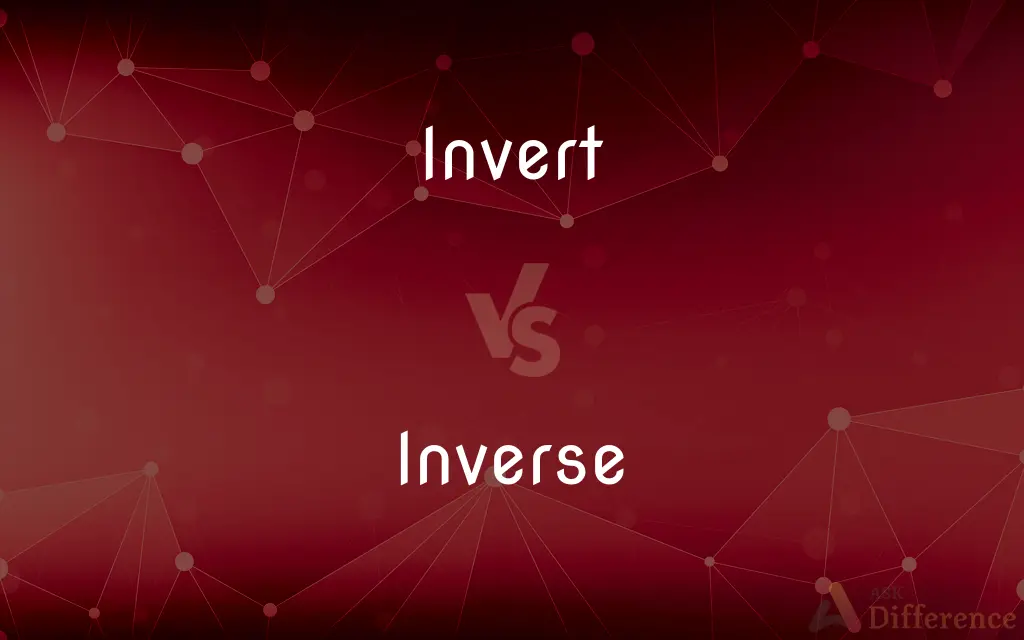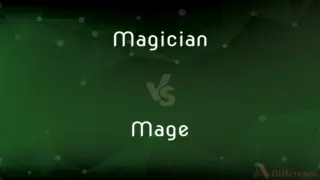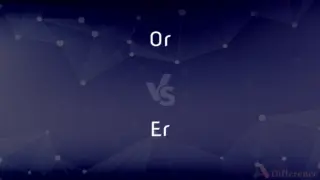Invert vs. Inverse — What's the Difference?
Edited by Tayyaba Rehman — By Urooj Arif — Updated on March 5, 2024
Invert refers to the action of turning something upside down or inside out, while inverse relates to a concept that is opposite or contrary in position, direction, order, or effect.

Difference Between Invert and Inverse
Table of Contents
ADVERTISEMENT
Key Differences
Inverting something involves a physical or metaphorical action that changes its orientation or order, such as flipping an image vertically or reversing the order of an array of numbers. The term inverse, however, is often used in a mathematical or abstract sense, referring to relationships or functions that operate in reverse to each other. For example, the inverse of addition is subtraction, and in geometry, the inverse of a function maps the output back to its original input. Inverse implies a natural or inherent opposition rather than an action.
Invert implies an active transformation where the original state is altered to its opposite in some specific aspect. While inversion is about the act of changing the state or position of something, inverse concepts usually have a predefined relationship that denotes reversal or opposition. Inversion can be applied in various contexts, such as technology, literature, and everyday life, to indicate the process of turning something around or upside down.
The inverse is a key concept in mathematics and science, used to describe phenomena, operations, or relationships that inherently counteract or undo each other. It's a fundamental idea in algebra and geometry, illustrating how certain operations can be reversed or undone to return to an original state.
Both invert and inverse enrich language and thought by providing ways to express reversal, opposition, and contrast. Understanding the distinction between them enhances clarity in communication, especially in fields like mathematics, science, and technology, where precision is crucial.
Comparison Chart
Definition
To turn something upside down or inside out.
Something opposite or contrary in position, direction, or effect.
ADVERTISEMENT
Usage
Physical or metaphorical action of reversal.
Describes a natural or inherent relationship of reversal.
Contexts
Applied in various contexts (e.g., technology, literature).
Primarily used in mathematics and science.
Example
Inverting a photograph so that the top becomes the bottom.
The inverse of multiplying by 2 is dividing by 2.
Nature
Active transformation.
Predefined oppositional relationship.
Compare with Definitions
Invert
Flipping the orientation of an object.
He decided to invert the image for a better composition.
Inverse
A concept of reversal in abstract or theoretical contexts.
The philosopher discussed the inverse nature of freedom and responsibility.
Invert
Changing the normal to the abnormal.
The documentary showcased how societal roles can invert under certain circumstances.
Inverse
Referring to the opposite direction or position.
The inverse path of the comet puzzled astronomers.
Invert
To reverse the position, order, or condition.
The software allowed us to invert the sequence of frames.
Inverse
Denoting a relationship where one element increases as another decreases.
The study revealed an inverse correlation between hours of sleep and stress levels.
Invert
Reversing the functionality or operation.
The engineer managed to invert the flow of data in the system.
Inverse
Opposite in relation to something else.
The inverse relationship between demand and supply is fundamental in economics.
Invert
To turn upside down or inside out.
The artist chose to invert the color scheme of the painting.
Inverse
A mathematical operation that undoes another.
Finding the inverse of a function is crucial in calculus.
Invert
To divert; to convert to a wrong use.
Inverse
Reversed in order, nature, or effect.
Invert
Turn inside out or upside down
Inverse
Reverse, opposite in order.
Inverse
Something inverted in sequence or character or effect;
When the direct approach failed he tried the inverse
Inverse
Opposite in nature or effect or relation to another quantity ;
A term is in inverse proportion to another term if it increases (or decreases) as the other decreases (or increases)
Common Curiosities
How is an inverse function used in mathematics?
An inverse function is used to reverse the operation of a given function, mapping the output back to its original input.
What does inverse mean in terms of effects?
In terms of effects, inverse means that the outcome or impact of one factor is opposite to that of another, often seen in scenarios where increasing one variable leads to a decrease in another.
Can the terms invert and inverse be used interchangeably?
While related, they should not be used interchangeably due to their distinct meanings: invert refers to an action of reversal, whereas inverse describes a relationship or state that is inherently opposite.
What is an example of an inverse relationship?
An example of an inverse relationship is the correlation between the volume and pressure of a gas at constant temperature, described by Boyle’s law in physics.
Is inversion always physical?
No, inversion can also be metaphorical or conceptual, referring to the reversal of ideas, roles, or abstract properties.
What does it mean to invert a concept?
To invert a concept means to consider or present it in a way that is opposite to its usual understanding or presentation.
Can a color scheme be inverted?
Yes, a color scheme can be inverted, typically by swapping each color with its opposite on the color wheel, often used for visual effects or to enhance readability.
What is the significance of inverse properties in algebra?
Inverse properties in algebra are fundamental for solving equations and understanding how operations relate to each other, enabling the manipulation and simplification of expressions.
How do you invert a process?
Inverting a process involves reversing its steps or operations to achieve an outcome that is opposite to the original process.
What role does inversion play in literature?
In literature, inversion can be used as a stylistic device to create emphasis, alter sentence structure, or present ideas and situations in a new or unexpected light.
Why is understanding inverse operations important?
Understanding inverse operations is crucial for solving equations, modeling real-world scenarios, and understanding the fundamental structure of mathematical systems.
Can weather patterns have inverse relationships?
Yes, certain weather patterns can exhibit inverse relationships, such as the inverse correlation between temperature and atmospheric pressure in some conditions.
What is an example of using inversion in daily life?
An example of using inversion in daily life could be rearranging the order of tasks to achieve a different outcome or perspective on a routine.
How is the concept of inverse used in technology?
In technology, the concept of inverse is used in algorithms, data processing, and engineering to design systems that operate based on reverse logic or function.
How does inversion affect a narrative in storytelling?
Inversion in storytelling can turn conventional narratives on their head, offering fresh perspectives or highlighting the contrast between expectations and reality.
Share Your Discovery

Previous Comparison
Magician vs. Mage
Next Comparison
Or vs. ErAuthor Spotlight
Written by
Urooj ArifUrooj is a skilled content writer at Ask Difference, known for her exceptional ability to simplify complex topics into engaging and informative content. With a passion for research and a flair for clear, concise writing, she consistently delivers articles that resonate with our diverse audience.
Edited by
Tayyaba RehmanTayyaba Rehman is a distinguished writer, currently serving as a primary contributor to askdifference.com. As a researcher in semantics and etymology, Tayyaba's passion for the complexity of languages and their distinctions has found a perfect home on the platform. Tayyaba delves into the intricacies of language, distinguishing between commonly confused words and phrases, thereby providing clarity for readers worldwide.













































